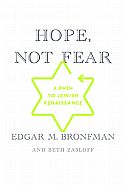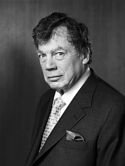TITLE: HOPE, NOT FEAR - A Path to Jewish Renaissance
Author: Edgar M. Bronfman and Beth Zasloff
Publisher: St. Martin’s Press
Genre: Non-Fiction
ISBN: 978-0-312-37792-2
Rating: Four (4) Stars (Out of Five)
Book review by Ray Palen
 |
Review
Formerly CEO of the Seagram Company Ltd., Edgar M. Bronfman is a renowned philanthropist and Jewish leader. He also established The Samuel Bronfman Foundation which supports initiatives that inspire a renaissance in Jewish life. With the writing of “HOPE, NOT FEAR”, Mr. Bronfman is challenging North American Jews to move away from a lifetime of fighting persecution and focus future efforts towards celebrating the joy of Judaism. He calls for welcome without conditions for intermarried families and disengaged Jews, for a celebration of Jewish diversity, and for openness to innovation and young leadership.
 |
With the assistance of Beth Zasloff, an alumna of the Bronfman Youth Fellowships, Edgar M. Bronfman has written a novel that speaks plainly and directly while never losing a sense of tradition and balance within the frameworks of common sense. Merely being concerned and participating in philanthropic efforts was not enough for him. He decided to actively champion a call for a Jewish Renaissance in North America. What he has actually put together is more of a wake-up call to all North American Jews that challenges them to heed his words and recognize their responsibility to help heal a broken world.
 |
Today, more Jews then ever are disconnected from Jewish life. It is this fact that Mr. Bronfman addresses with suggestions for how to resolve this issue. “HOPE, NOT FEAR’ comes out of several years of writing and conducting over seventy individuals who are passionately concerned about the future of Judaism. One of the first questions that is posed is how to negotiate respect for tradition while adapting to a changing world. Bronfman states that “anti-Semitism certainly has not disappeared entirely, (but) it is no longer a significant force in North American life. There if no more need for this ‘fear’ and the proclamation Never Again is still a mantle to be passed from generation to generation. Fear of not being able to prevent another Holocaust is not as prevalent now as it was a few decades ago. The myriad of films released recently dealing with this subject: “The Boy In the Striped Pyjamas”, “The Reader”, “Defiance”, and “A Secret” are evidence of this.
Richard Joel, former president and international director of Hillel, now president of Yeshiva University, states that “being Jewish used to be a condition and now it’s an option.” Rabbi Isidore Twersky expressed a vision for Jewish renaissance: Our goal should be to make it possible for every Jewish person, child or adult, to be exposed to the mystery and romance of Jewish history. These are but a few of the references cited in Bronfman’s call for a Golden Age for North American Jewry.
In referencing the story of Abraham and Sarah’s Tent, Bronfman takes on the subject of Intermarriage – a major cause in the declining numbers of practicing Jews. He states that the problem is not that Jews are falling in love with non-Jews but that they aren’t falling in love with Judaism. Additionally, without the glue of anti-Semitism, the Jewish community is breaking down into antagonistic groups. The fact that the Jewish community continues to fight about who is a Jew is self-defeating. Bronfman suggests, instead of arguing about inclusion and exclusion, let us embrace the Jewish ethic of caring for our fellow human beings.
Part of the Jewish Renaissance is The Reform Movement. This initiative is an “outreach” best described by Rabbi Alexander Schindler (1978) who saw the intermarriage opportunity as a call to welcome “Jews by choice” and to interfaith marriages. Efforts must be made to “reach” the modern Jew. Rabbi Avi Weiss stated: “…the key to reaching an unaffiliated Jew is through love. To welcome people and accept them for who they are, no strings attached. To remember there are different ways of reaching Jews.” Just as Abraham’s Tent was open on all sides so must the modern Jewish community be open to new ideas, conditions and models of Judaism. Mr. Bronfman states that his goal is to get 100 percent of Jews to have some Jewish knowledge, because they can’t be proud Jews if they don’t know anything about Judaism. He hopes that “perhaps someday we won’t call ourselves Orthodox, Reform, Conservative, or Reconstructionist Jews but simply Jews.”
The second part of Edgar M. Bronfman’s book deals with Making Renaissance Happen. This plan of action involves three specific initiatives:
- Bring Jewish Life To Large Numbers Of Jewish Youth
- Pass The Torch To A New Generation Of Leaders
- Update Our Institutions
The first initiative has brought about things like Hillel, Jewish Camps and Birthright Israel – which has sent more than 100,000 young people to Israel to participate in a 10-day journey into Jewish history and culture. Birthright generates excitement about Judaism and Hillel, an old organization with a new vision, offers concrete ways to translate that excitement into action. Jewish camp, a transformative experience created by Rabbi Daniel Lehmann, has been funded by the Bronfman Youth Fellowship as an example of how the energy of one initiative can feed into another.
Passing the torch to new Jewish leaders involves the identification and nurturing of small numbers of talented individuals in the hopes that they will take responsibility for Jewish future. This was the impetus behind the creation of the Bronfman Youth Fellowships in Israel (BYFI) – a program that sends 26 outstanding Jewish teenagers to Israel for five weeks. Since its creation in 1987, over 500 have now gone through the fellowship. The one individual who has probably done the most in the area of building vision and knowledge in Jewish leadership is Leslie Wexner, founder of The Limited, Inc. (now Limited Brands). The Wexner Foundation provides programs that focus on identifying, cultivating, nurturing, and empowering leaders for the next generations in Jewish life.
Jewish Communal Life is the focus of updating institutions. Communities such as IKAR (meaning “root” or “essence”) started by Rabbi Sharon Brous in Los Angeles that defines itself as a “Jewish spiritual community that stands at the intersection of spirituality and social justice.” The one place, Bronfman feels, where the most impact is to be made is within the Jewish Home. The Jewish home should be a place “where children understand Jewish culture as an integral part of family culture. Jewish ethics, tradition, and ritual should be a part of family life, so that from an early age children understand Judaism as something that their parents deeply value.” The cycle of the Jewish High Holy Holidays, from Rosh Hashanah to Yom Kippur, offer tremendous opportunity for introspection and transformation.
“HOPE, NOT FEAR” closes with a glossary of Jewish Renaissance Initiatives as well as a full listing of all the interviews conducted by Mr. Bronfman and Ms. Zasloff in putting this novel together. “HOPE, NOT FEAR” has been called a “brave, honest, painful and joyous book.” At the very least, it should be read and discussed openly in the spirit of familial and community engagement.
Reviewed by Ray Palen
